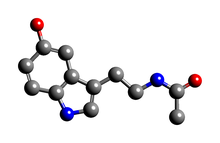N-Acetylserotonin

| |

| |
| Names | |
|---|---|
| Preferred IUPAC name
N-[2-(5-Hydroxy-1H-indol-3-yl)ethyl]acetamide | |
| Other names
N-Acetyl-5-hydroxytryptamine
N-Acetyl-5-HT | |
| Identifiers | |
3D model (JSmol)
|
|
| ChEBI | |
| ChEMBL | |
| ChemSpider | |
| DrugBank | |
| ECHA InfoCard | 100.013.560 |
| MeSH | N-AcetylserotoninN-Acetylserotonin |
PubChemCID
|
|
| UNII | |
CompTox Dashboard(EPA)
|
|
| |
| |
| Properties | |
| C12H14N2O2 | |
| Molar mass | 218.256g·mol−1 |
| Density | 1.268 g/mL |
Except where otherwise noted, data are given for materials in theirstandard state(at 25 °C [77 °F], 100 kPa).
| |
N-Acetylserotonin(NAS), also known asnormelatonin,is anaturally occurringchemicalintermediatein theendogenousproduction ofmelatoninfromserotonin.[1][2]It also hasbiological activityin its own right, including acting as amelatonin receptor agonist,anagonistof theTrkB,and havingantioxidanteffects.
Biological function[edit]
Like melatonin, NAS is anagonistat themelatonin receptorsMT1,MT2,andMT3,and may be considered to be aneurotransmitter.[3][4][5][6]In addition, NAS is distributed in some areas of thebrainwhere serotonin and melatonin are not, suggesting that it may have unique central duties of its own instead of merely functioning as aprecursorin thesynthesisof melatonin.[3]NAS is known to have anti-depressant, neurotrophic and cognition-enhancing effects[7][8]and has been proposed to be a target for the treatment of aging-associated cognitive decline and depression[8]
TrkB receptor[edit]
NAS has been shown to act as apotentTrkB receptoragonist, while serotonin and melatonin do not.[3]Subchronic and chronic administration of NAS to adult mice induces proliferation of neural progenitor cells(NPC)s, blockage of TrkB abolished this effect suggesting that it is TrkB-dependent.[9]NAS was also found to significantly enhance NPC proliferation in sleep-deprived mice.[9]It is thought that the anti-depressant and neurotrophic effects of NAS are in part due to its role as a TrkB agonist.[7]
Antioxidant properties[edit]
NAS acts as a potentantioxidant,NAS effectiveness as an anti-oxidant has been found to be different depending on the experimental model used, it has been described as being between 5 and 20 times more effect than melatonin at protecting against oxidant damage.[10]NAS has been shown to protect againstlipid peroxidationin microsomes and mitochondria.[11]NAS has also been reported to lower resting levels ofROSin peripheral blood lymphocytes and to exhibit anti-oxidant effects against t-butylated hydroperoxide- and diamide-induced ROS.[12]NAS has also been observed to inhibitnitric oxide synthase.[13]
Anti-inflammatory effects[edit]
NAS has been reported to haveanti-inflammatoryeffects. NAS has been shown to inhibitLPS-stimulated production of theproinflammatory cytokineTNF-alphain differentiated THP-1-derived human monocytes.[14]
Miscellaneous[edit]
NAS may play a role in the antidepressant effects ofselective serotonin reuptake inhibitors(SSRIs) andmonoamine oxidase inhibitors(MAOIs).[3]The SSRIfluoxetineand theMAO-AinhibitorclorgylineupregulateAANAT indirectly throughserotonergicmechanisms and thereby increase NAS levels after chronic administration, and this correlates with the onset of their antidepressant effects.[3][15]Furthermore, light exposure inhibits the synthesis of NAS and reduces the antidepressant effects of MAOIs.[3]In addition, AANATknockout micedisplay significantly greater immobility times versus control mice inanimal modelsofdepression.[3]These data support a potential role for NAS in mood regulation and in antidepressant-induced therapeutic benefits.
Through a currently unidentified mechanism, NAS may be the cause of theorthostatic hypotensionseen with clinical treatment of MAOIs.[15][16]It reducesblood pressurein rodents, andpinealectomy(thepineal glandbeing a major site of NAS and melatonin synthesis) abolishes thehypotensiveeffects ofclorgyline.[15][16]
Biochemistry[edit]
NAS is produced from serotonin by theenzymearalkylamineN-acetyltransferase(AANAT) and is converted to melatonin byacetylserotoninO-methyltransferase(ASMT).
NAS is able to penetrate theblood–brain barrier,unlike serotonin.[17]
See also[edit]
References[edit]
- ^AXELROD J, WEISSBACH H (April 1960). "Enzymatic O-methylation of N-acetylserotonin to melatonin".Science.131(3409): 1312.Bibcode:1960Sci...131.1312A.doi:10.1126/science.131.3409.1312.PMID13795316.S2CID22341451.
- ^WEISSBACH H, REDFIELD BG, AXELROD J (September 1960). "Biosynthesis of melatonin: enzymic conversion of serotonin to N-acetylserotonin".Biochimica et Biophysica Acta.43:352–3.doi:10.1016/0006-3002(60)90453-4.PMID13784117.
- ^abcdefgJang SW, Liu X, Pradoldej S, et al. (February 2010)."N-acetylserotonin activates TrkB receptor in a circadian rhythm".Proceedings of the National Academy of Sciences of the United States of America.107(8): 3876–81.Bibcode:2010PNAS..107.3876J.doi:10.1073/pnas.0912531107.PMC2840510.PMID20133677.
- ^Zhao H, Poon AM, Pang SF (March 2000). "Pharmacological characterization, molecular subtyping, and autoradiographic localization of putative melatonin receptors in uterine endometrium of estrous rats".Life Sciences.66(17): 1581–91.doi:10.1016/S0024-3205(00)00478-1.PMID11261588.
- ^Nonno R, Pannacci M, Lucini V, Angeloni D, Fraschini F, Stankov BM (July 1999)."Ligand efficacy and potency at recombinant human MT2 melatonin receptors: evidence for agonist activity of some mt1-antagonists".British Journal of Pharmacology.127(5): 1288–94.doi:10.1038/sj.bjp.0702658.PMC1566130.PMID10455277.
- ^Paul P, Lahaye C, Delagrange P, Nicolas JP, Canet E, Boutin JA (July 1999)."Characterization of 2-[125I]iodomelatonin binding sites in Syrian hamster peripheral organs".The Journal of Pharmacology and Experimental Therapeutics.290(1): 334–40.PMID10381796.
- ^abTosini G., Ye K. & Iuvone PM (2012)."Neuroprotection, neurogenesis, and the sleepy brain".Neuroscientist.18(6): 645–653.doi:10.1177/1073858412446634.PMC3422380.PMID22585341.
- ^abOxenkrug G. & Ratner R. (2012)."N-acetylserotonin and aging-associated cognitive impairment and depression".Aging Dis.3(4): 330–338.PMC3501368.PMID23185714.
- ^abSompol P.; Liu X.; Baba K.; Paul KN.; Tosini G.; Iuvone PM.; Ye K. (2011)."N-acetylserotonin promotes hippocampal neuroprogenitor cell proliferation in sleep-deprived mice".Proc. Natl. Acad. Sci. U.S.A.108(21): 8844–9.Bibcode:2011PNAS..108.8844S.doi:10.1073/pnas.1105114108.PMC3102377.PMID21555574.
- ^Oxenkrug G (2005). "Antioxidant effects of N-acetylserotonin: possible mechanisms and clinical implications".Ann. N. Y. Acad. Sci.1053:334–47.doi:10.1111/j.1749-6632.2005.tb00042.x.PMID16179540.S2CID94273958.
- ^Gavazza MB.; Català A. (2004). "Protective effect of N-acetyl-serotonin on the nonenzymatic lipid peroxidation in rat testicular microsomes and mitochondria".J. Pineal Res.37(3): 153–60.doi:10.1111/j.1600-079x.2004.00150.x.PMID15357659.S2CID6974587.
- ^Wölfler A.; Abuja PM.; Schauenstein K.; Liebmann PM. (1999). "N-acetylserotonin is a better extra- and intracellular antioxidant than melatonin".FEBS Lett.449(2–3): 206–10.doi:10.1016/s0014-5793(99)00435-4.PMID10338133.S2CID32077728.
- ^Peter Klemm; Markus Hecker; Hannelore Stockhausen; Chin Chen Wu; Christoph Thiemermann (Aug 1995)."Inhibition by N-acetyl-5-hydroxytryptamine of nitric oxide synthase expression in cultured cells and in the anaesthetized rat".Br J Pharmacol.115(7): 1175–1181.doi:10.1111/j.1476-5381.1995.tb15021.x.PMC1908794.PMID7582541.
- ^Perianayagam MC.; Oxenkrug GF.; Jaber BL. (2005). "Immune-modulating effects of melatonin, N-acetylserotonin, and N-acetyldopamine".Ann. N. Y. Acad. Sci.1053:386–93.doi:10.1111/j.1749-6632.2005.tb00046.x.PMID16179544.S2CID592935.
- ^abcOxenkrug GF (1999). "Antidepressive and antihypertensive effects of MAO-A inhibition: role of N-acetylserotonin. A review".Neurobiology (Budapest, Hungary).7(2): 213–24.PMID10591054.
- ^abOxenkrug GF (1997). "[N-acetylserotonin and hypotensive effect of MAO-A inhibitors]".Voprosy Meditsinskoi Khimii(in Russian).43(6): 522–6.PMID9503569.
- ^"N-Acetyl Serotonin".DrugBank.
